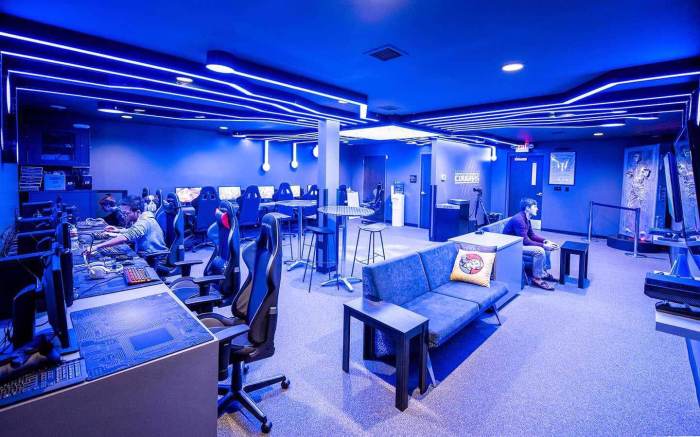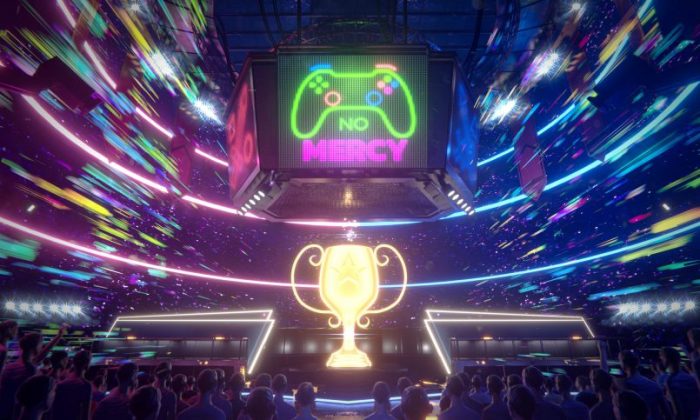Esports Infrastructure isn’t just about PCs and fast internet; it’s the entire ecosystem fueling the explosive growth of competitive gaming. From the high-powered servers hosting matches to the dazzling stadiums packed with screaming fans, every element plays a crucial role in delivering a thrilling and professional experience. Think of it as the backbone of a multi-billion dollar industry, constantly evolving to meet the demands of increasingly sophisticated games and a ravenous global audience.
This exploration dives into the nitty-gritty of what makes esports tick, covering everything from the hardware and software requirements to the logistical challenges of running a major tournament. We’ll explore the environmental impact of this burgeoning industry and gaze into the crystal ball to predict the future of esports infrastructure, with emerging technologies like cloud gaming and VR/AR poised to revolutionize the scene.
Get ready to level up your understanding!
Hardware and Software Requirements

Setting up a professional esports infrastructure requires a serious investment in both hardware and software. High-performance components are crucial for ensuring smooth gameplay and broadcast quality, while robust software solutions manage the complexities of competitive gaming. This section details the essential elements for a successful esports setup.
High-Performance Hardware Specifications
Top-tier esports PCs demand powerful components to handle the demands of modern games at high frame rates and resolutions. This ensures a competitive edge for players and a visually stunning experience for viewers. Key components include high-end CPUs (e.g., Intel Core i9 or AMD Ryzen 9 series), powerful GPUs (e.g., NVIDIA GeForce RTX 4090 or AMD Radeon RX 7900 XTX), ample RAM (at least 32GB DDR5), and fast NVMe SSD storage.
For broadcasting, high-quality capture cards (e.g., Elgato 4K60 Pro MK.2) are essential for capturing gameplay footage without significant lag or compression artifacts. Furthermore, robust network interface cards (NICs) with multiple gigabit Ethernet ports are needed to handle the high bandwidth demands of both gameplay and streaming.
Software Solutions for Esports
The software side of esports infrastructure is just as critical as the hardware. Game servers, crucial for maintaining game integrity and fairness, require dedicated software tailored to each game. These servers manage player connections, enforce game rules, and ensure fair gameplay. Popular streaming platforms like Twitch and YouTube Gaming utilize their own software for broadcasting, requiring optimized encoders and reliable internet connections.
Tournament management software is also essential, handling registration, bracket creation, scheduling, and live score updates. Examples include platforms that provide comprehensive features such as player management, score tracking, and live streaming integration.
Network Infrastructure for Competitive Play
The network infrastructure is the backbone of any esports setup. High bandwidth is essential for both gameplay and streaming, ensuring low latency and minimizing packet loss. A dedicated, low-latency network connection is critical for minimizing lag and ensuring smooth gameplay, crucial for competitive gaming where milliseconds can make the difference between victory and defeat. Considerable investment in robust network equipment, such as high-end routers and switches capable of handling high bandwidth and minimizing latency, is necessary.
Redundancy is also crucial to prevent service disruptions during critical events. For example, a professional tournament might use multiple gigabit internet connections with load balancing to ensure high availability. Furthermore, a well-designed network architecture minimizes latency and ensures consistent performance.
Data Flow in a Professional Esports Tournament Setup
Imagine a diagram illustrating the data flow. At the heart is the game server, receiving player input from numerous high-performance PCs connected via a dedicated network. This server processes game logic and transmits the game state back to each player. Simultaneously, capture cards on each player’s PC capture their gameplay, sending the video stream to dedicated encoding servers. These servers compress and optimize the video streams before sending them to the streaming platforms (Twitch, YouTube Gaming).
Meanwhile, the tournament management software receives data from the game server (match results, player statistics) and potentially from other sources (spectator counts, chat interactions) to manage the event and provide real-time updates to viewers. This entire process relies on a robust, low-latency network to ensure smooth data flow and a high-quality viewing experience. The entire setup is designed for maximum redundancy and stability to minimize the risk of outages during the crucial moments of competition.
Broadcasting and Streaming

Esports broadcasting and streaming are crucial for delivering the excitement of competitive gaming to a global audience. This involves a complex interplay of technologies, skilled personnel, and strategic platform choices to ensure a high-quality and engaging viewing experience. Success hinges on seamless delivery and a captivating presentation, translating the in-game action into a compelling spectacle for viewers.
The process of broadcasting and streaming esports events relies on a sophisticated technological infrastructure. Key technologies include high-quality video encoding to compress video for efficient transmission, robust content delivery networks (CDNs) for global reach and low latency, and various streaming platforms that offer diverse features and audience reach. The production process also utilizes specialized software for switching between camera angles, adding graphics and overlays, and incorporating commentator audio.
Streaming Platforms
Choosing the right streaming platform is a critical decision for esports organizers. Different platforms offer varying features, audience reach, and monetization options. Twitch, for example, boasts a massive audience primarily focused on gaming, while YouTube Gaming provides a broader reach encompassing other content categories. Facebook Gaming offers strong community features and integration with other Facebook services. Each platform has its strengths and weaknesses regarding viewer interaction tools, monetization strategies (e.g., subscriptions, donations, ads), and overall audience demographics.
The selection depends on the specific event, target audience, and overall marketing strategy. For example, a smaller, niche esports tournament might find success on a platform like Trovo, which focuses on specific game communities, while a major international tournament would likely leverage the massive reach of Twitch or YouTube Gaming.
Production Roles and Their Impact
The success of an esports broadcast goes beyond just the game itself. A skilled production crew, including commentators, analysts, and technical staff, plays a vital role in shaping the viewer experience. Commentators provide real-time play-by-play, enhancing the excitement and engagement. Analysts offer strategic insights and context, enriching the viewing experience for both casual and hardcore fans. The technical crew, responsible for camera operation, graphics, and audio mixing, ensures a smooth and professional broadcast.
For example, a skilled analyst might explain the strategic implications of a player’s decision, adding depth to the viewing experience beyond the immediate action on screen. A well-coordinated production team ensures a consistent and engaging stream, maximizing the enjoyment and understanding for the audience.
Esports Streaming Workflow
The process of streaming an esports event involves a multi-stage workflow, beginning with capturing the game footage and culminating in the live broadcast to viewers.
A simplified workflow diagram would illustrate the following stages:
- Game Capture: Game footage is captured from the players’ computers using capture cards or software.
- Signal Routing: The captured signal is routed to a production switcher.
- Production & Mixing: The production switcher allows for switching between different camera angles, adding graphics and overlays, and incorporating commentator audio.
- Encoding: The combined video and audio signals are encoded into a format suitable for streaming (e.g., H.264, H.265).
- Streaming: The encoded stream is uploaded to the chosen streaming platform via a CDN.
- Distribution: The streaming platform distributes the stream to viewers globally.
The Future of Esports Infrastructure

Esports infrastructure is poised for a massive transformation, driven by rapid advancements in technology. The next decade will see a significant shift in how we experience, organize, and broadcast competitive gaming, fundamentally altering the landscape of the industry. This evolution will be shaped by the integration of emerging technologies, each presenting unique opportunities and challenges.
Cloud Gaming’s Impact on Esports
Cloud gaming’s low barrier to entry will democratize esports participation. Players will no longer need high-end PCs to compete at a high level, opening the doors to a broader, more diverse player base. Tournament organizers can leverage cloud infrastructure to reduce logistical complexities associated with providing hardware for large-scale events. This could lead to more accessible and geographically diverse tournaments.
However, concerns remain regarding latency and network stability, crucial factors in competitive gaming. Reliable, low-latency cloud infrastructure is essential for widespread adoption in esports. The success of services like Xbox Cloud Gaming and GeForce Now suggests a positive trajectory, but challenges in providing consistently low ping across diverse geographic locations remain.
Virtual and Augmented Reality’s Role in Esports
VR and AR technologies promise immersive and interactive spectator experiences. Imagine watching a match from the perspective of a player, or having AR overlays providing real-time statistics and player information directly onto your view of the game. For players, VR could offer enhanced training simulations and more realistic gameplay environments. The integration of AR into broadcasting could lead to innovative ways of engaging audiences and enhancing the viewing experience.
Challenges include the cost of VR/AR hardware and software, the need for robust infrastructure to support high-bandwidth streaming, and the development of compelling VR/AR experiences specifically tailored to esports. The current limitations in widespread consumer adoption of VR headsets represent a significant hurdle to overcome. However, advancements in technology are gradually reducing the cost and improving the user experience, making it a technology to watch closely.
Artificial Intelligence in Esports
AI is poised to revolutionize esports in several ways. AI-powered analytics can provide valuable insights into player performance, strategy, and team dynamics. This data can be used to improve player training, optimize team compositions, and even predict match outcomes. AI could also be used to automate various aspects of tournament organization, such as scheduling, matchmaking, and even refereeing. However, ethical considerations around AI’s use in competitive gaming need careful consideration.
Concerns about fairness, bias, and the potential for AI to undermine human skill and judgment need to be addressed. The use of AI in automated commentary or real-time strategic analysis is a promising area, but the potential for bias in algorithms needs careful monitoring and mitigation.
Timeline of Future Technologies in Esports Infrastructure
The following timeline provides a projected timeframe for the development and implementation of key future technologies in esports infrastructure. These are estimates based on current technological advancements and industry trends, and are subject to change.
| Technology | 2024-2026 | 2027-2029 | 2030+ |
|---|---|---|---|
| Cloud Gaming Widespread Adoption in Esports | Increased use in smaller tournaments and training | Mainstream adoption in major tournaments | Ubiquitous use; Cloud-native games dominate |
| VR/AR in Esports Broadcasting | Experimental implementations in select events | Wider adoption; immersive viewing options become common | Integrated into mainstream broadcasts; AR overlays become standard |
| AI-powered Analytics and Automation | Increased use in player performance analysis | AI-driven matchmaking and automated scheduling become common | AI referees and commentators; highly personalized viewing experiences |
Popular Questions: Esports Infrastructure
What’s the difference between esports infrastructure and regular gaming infrastructure?
Esports infrastructure demands significantly higher performance standards. Think lower latency, greater bandwidth, and far more robust server capacity to handle the demands of competitive play and live streaming to massive audiences. Regular gaming focuses on individual experiences, while esports is all about a seamless, lag-free experience for multiple players and viewers.
How much does it cost to build esports infrastructure?
Costs vary wildly depending on scale. A small-scale tournament might cost a few thousand dollars, while a major event could easily reach millions, encompassing venue rental, hardware, software, staffing, and marketing.
What are some common career paths in esports infrastructure?
Plenty of opportunities exist! You could be a network engineer, server administrator, broadcast technician, event planner, or even a cybersecurity specialist, all crucial roles in keeping the esports world running smoothly.
What role does cloud gaming play in the future of esports?
Cloud gaming has the potential to democratize esports, allowing players with less powerful hardware to compete at a high level. It also simplifies tournament organization and reduces the need for massive on-site hardware deployments.
